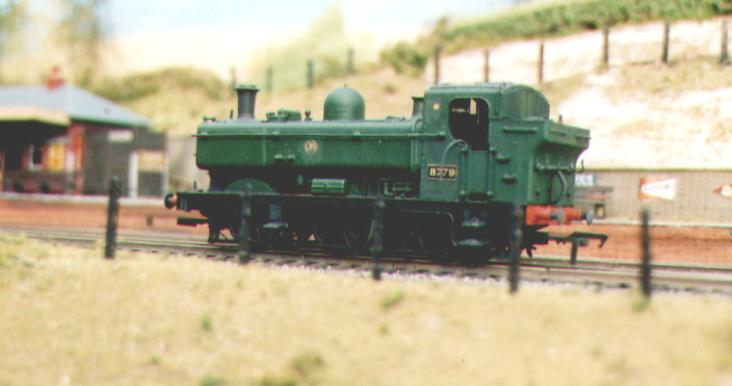 |
"No. 8779, a Pannier Tank with the later cab, pauses for a photo."
indent Small layouts demand small engines. True, the 57xx pannier is nothing like as small as some of those the GWR used in the 30s and 40s but, being a class of over 800, it was one of the most common. Shunting layouts also demand reliable engines and the new Bachmann model is not only the most accurate to date but also far and away the best performer. Unfortunately, as I write this it is only available in BR black but no doubt Bachmann will produce not only the more familiar GW green liveries but also this rather rarer post-1935 variety with the "Shirtbutton" logo; given time!
indent Good as the Bachmann model is, I
still felt there were a few omissions so, bearing in mind we had to repaint it anyway, we
added a few details such as tinplate lamp irons, proper brass number plates and a
tinned-copper wire "slaking pipe"; the rubber hose seen dangling out of the the
cab in around half the photos of GWR tank engines I've ever seen! Some fire irons on
the back brackets, a load of rather poor quality war-time coal and a coat of post-1927 GWR
green preceded the application of the appropriate HMRS transfers and weathering.
indent Finally, the removal of one of the coupling hooks
improves the appearance slightly but moreover, with similar treatment to all stock on the
layout, uncoupling by hand (using a tapered uncoupling pad on a stick), is so much
easier. On any small layout which does not have a return loop, a "turntable
fiddle yard" or a triangle somewhere this treatment is recommended. Not only
does shunting on the layout become much easier but "crane-shunting" the stock by
hand between sessions becomes simpler too. Unfortunately 3-link couplings are
really not an option on a layout with curves as sharp as this, even if your eyesight is
good enough to be able to use them!
| Previous photograph in series | Back to "Upper Isis Room" entrance | Next photograph in series |